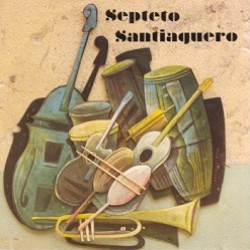
Llega con el son más joven del Oriente cubano. Herederos del legado de Melodías de Ayer, un heterodoxo y veterano grupo, habitual de la Casa de la Trova de Santiago de Cuba, pero también de otros grupos, los más jóvenes Sones de Oriente o el Septeto Luz, en 1993, bajo el liderazgo del tresero Fernando Dewar, se ciñen a la disciplina del septeto tradicional, sin más licencia que la incorporación de la tumbadora, a mayor gloria de Arsenio Rodríguez.
Dos cantantes mantienen la tradición santiaguera del canto a dos voces: prima y segunda. Pletórico de contagiosa energía de principio a fin.
PRENSA:
"Fieles a la ortodoxia del sonido, dotados de una excelente combinación de voces, el joven grupo de Santiago de Cuba pone sobre el escenario todas las promesas de su primer álbum. Su título fetiche, La bomba lacrimosa, una joya olvidada de repertorio del gran Miguel Matamoros.”
(Liberation)
ENGLISH:
Septeto Santiaguero was founded in 1995 by members of Melodías de Ayer, a group formed in the early sixties which together with the Estudiantina Invasora and the Cuarteto Patria, had for over three decades animated many a day and night at the Casa de la Trova in Santiago de Cuba.
Seeking to return to their roots, they decided to give up the mambos and stick to the discipline of the traditional septet –guitar, tres, bongos, clave, maracas, contrabass and trumpet with the addition of the drum, which they retained in honour of Arsenio Rodríguez. In the Santiago de Cuba style, the two singers maintain the first and second harmony with equal emphasis.
Despite the fact that the group is eight in number, they retained the name Septeto Santiaguero because the way they perform the son, the bolero, the guaracha, the guajira, and the guaguancó is otherwise completely rooted in the septeto sound. Together they have created a group which preserves and pays homage to one of Cuba's most important musical forms, with a vitality demonstrating that the septeto tradition is still fresh and alive in Santiago de Cuba today.